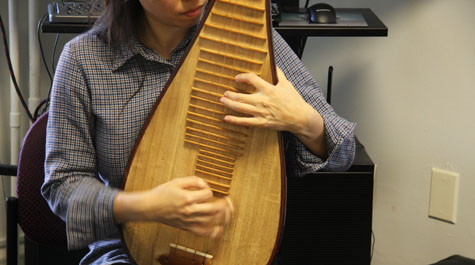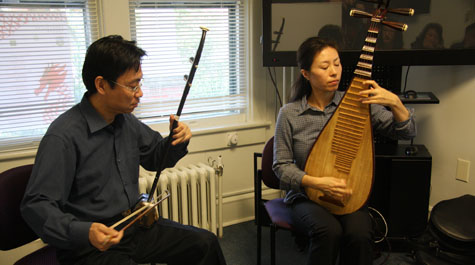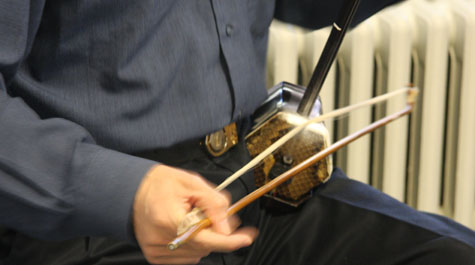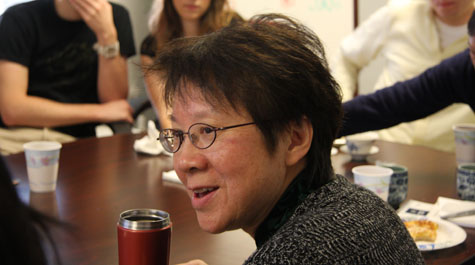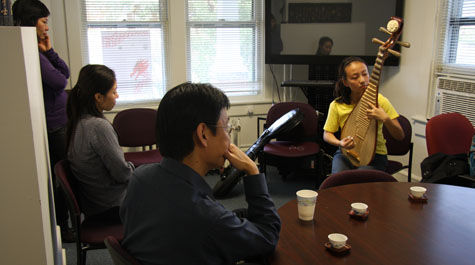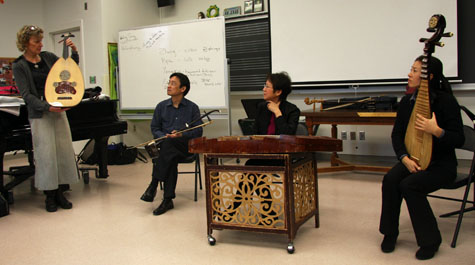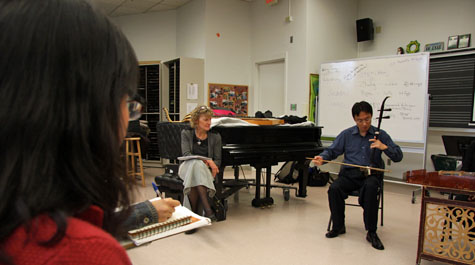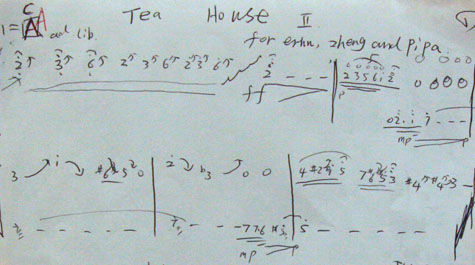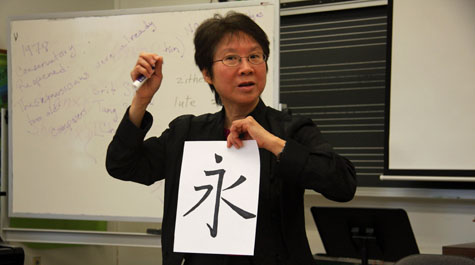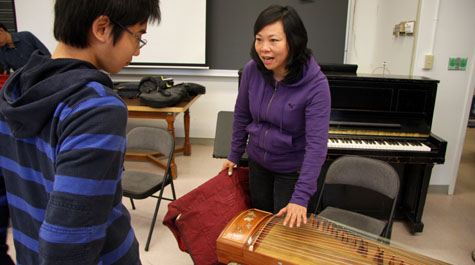Ensemble brings ‘language’ of Chinese music to W&M
A group of William & Mary students had a unique picnic of sorts at the Confucius Institute on Monday. While enjoying pizza on paper plates and tea in delicate porcelain cups, they were treated to a performance by members of the Music from China ensemble as well as a question-and-answer session with the group’s founder.
“Music is the essence of virtue,” said founder Susan Cheng. “That’s what Confucius taught.”
The ensemble was at William & Mary this weekend as part of the Ewell Concert series. Students who saw the group perform on Sunday were able to interact with the ensemble on Monday during both the lunchtime session at the Confucius Institute and a late-afternoon workshop. On Tuesday, students in Anne Rasmussen’s “World of Music” class were treated to one final interaction with the group, learning more about instruments like the “yangqin” and “zheng” and the cultural and historical influences on Chinese music. The visit by the ensemble was cosponsored by the Confucius Institute.
{{youtube:medium:left|kYzDWU7ieBM, The Music from China ensemble performs in a "Worlds of Music" class at W&M}}
“It’s just been a really terrific opportunity to have them here and have them expand my teaching repertoire and learn about a really important, thriving music that -- because of the Chines Diaspora -- is in so many places in the world, but significantly in the United States,” said Rasmussen, chair of the music department.
As students finished their lunch during the noontime event on Monday, Wang Guowei and Sun Li performed a traditional folk piece titled “Jasmine,” which Giacomo Puccini used in his opera “Turandot.” Guowei played on a fiddle-like instrument called an “erhu” while Li performed on a lute called a “pipa.”
Cheng explained the two instruments, noting the snake skin on the erhu and its attached bow. She also pointed out the plastic “false nails” that Yihan wore to protect her fingers from the steel strings of the pipa, which earned its name from the sound that is produced when the strings are plucked back and forth.
“It’s a very flat instrument, but the sound is still very resonant,” said Cheng.
Chinese music is like a language, Cheng said, adding that the Chinese language is very tonal to begin with. If those tones are exaggerated, you end up with music, she said.
“There’s a very close proximity between the spoken word and music,” Cheng said.
Cheng noted that during the Cultural Revolution in China that took place between 1966 and 1976, the government hired musicians to produce music as propaganda, and, as such, they became well known and highly esteemed.
Although that has changed today, many young people in China still seek out a musical education, said Cheng. Though many play traditional music, wealthier Chinese families are able to provide more-expensive lessons on Western instruments like the piano or violin to their children.
The influence of the West is also seen in the new music being produced in China, said Cheng. Western harmonies were once alien to Chinese music, which traditionally is played in unison with small variations. However, Chinese musicians have begun to take in Western harmonies and make them their own, she said.
The people playing music in China have also changed, she noted. In the 1950s and 60s, the majority of orchestras in China were male. Today, they are mostly female.
“All of these opportunities have opened up for women,” said Cheng.
Rasmussen said that she often seeks ways to take advantage of the musicians who come to campus through the Ewell Concert Series by having the guest musicians give workshops or present in classes.
In her “Worlds of Music” class on Tuesday, Guowei and Li were joined by Cheng on a hammered dulcimer called a “yangqin” and Jun Ling Wang on a zither called a “zheng.”
The class had been studying Chinese music for a couple of weeks prior, but Rasmussen said she preferred learning about music from the musicians themselves and not from books or films.
Cheng explained the four instruments, and Rasmussen showed the class some of their global equivalents, like the “qanun” – the Arabic version of the dulcimer. The group also played a few selections, showcasing examples of opera, new music and other genres.
When the class ended, students were able to examine the instruments up close and ask the musicians a few more questions before the ensemble had to leave, ending a very busy – and productive -- few days at William & Mary.
Rasmussen noted that the visit allowed her to celebrate the Chinese students in the William & Mary population – three of whom are in her “World of Music” class.
It may be some of those same students who perform the next Chinese music concert at William & Mary.
“The visit by the Music from China group gives us great ideas about ways to expand the study and the appreciation of Chinese culture at W&M and in the local communities,” says Professor Yanfang Tang, director of the Confucius Institute at W&M. “Many of our Chinese students at William & Mary are talented players of the Chinese musical instruments. The Confucius Institute can acquire the instruments so that W&M students may form their very own Chinese music ensemble."















